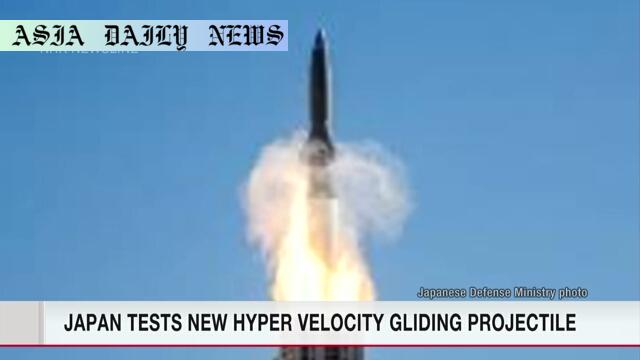Hyper Velocity Gliding Projectile tested as part of Japan’s plan to defend remote islands, with deployment expected by 2026.
- Japan’s Defense Ministry tested the Hyper Velocity Gliding Projectile in the US.
- The missile is designed for the defense of remote Japanese islands, aiming for deployment by 2026.
- The HVGP is highly resistant to interception, complementing Japan’s advanced missile defense systems.
- Japan is also developing an upgraded Type-12 missile and hypersonic weaponry capable of counterstrikes during emergencies.

Introduction: Japan’s Missile Advancements
In a notable advancement in defense technology, Japan’s Defense Ministry has successfully conducted four tests of its Hyper Velocity Gliding Projectile (HVGP) in the United States. These tests, which took place between August 2022 and January 2023, mark a significant step forward in Japan’s efforts to strengthen its missile defense capabilities and protect its territorial integrity, particularly the remote island regions.
What is the Hyper Velocity Gliding Projectile?
The HVGP is a cutting-edge missile system designed to travel at hypersonic speeds, with maneuverability that makes it exceptionally difficult to intercept. This advanced technology provides Japan with a strategic advantage in missile defense. The missile is part of a broader initiative to enhance Japan’s ability to respond to emerging threats in the Asia-Pacific region, particularly in light of increasing tensions in the region.
Research and development for the HVGP began back in fiscal 2018. Since then, the project has been given a high priority, reflecting Japan’s commitment to bolstering its national security. Unlike conventional missiles, the HVGP employs a gliding phase that allows it to evade interception with precision and speed.
Test Success and Photos Reveal Progress
The tests of the HVGP were conducted using a ground-based launcher, affirming the feasibility of the system. Photos released by Japan’s Defense Ministry showcase the launcher and highlight the advanced nature of the equipment utilized. Each of the four tests was deemed successful, with all flight paths proceeding as planned.
The success of these tests underscores the missile’s development progress and builds confidence in its future deployment. Ministry officials are optimistic about achieving a full operational version of the HVGP by fiscal 2026, a timeline that aligns with Japan’s strategic defense goals.
Complementary Missile Projects
The HVGP is not the only missile under development by Japan’s Defense Ministry. An upgraded Type-12 surface-to-ship missile is also being engineered, with a significantly extended range of about 1,000 kilometers. This upgrade is intended to provide Japan with enhanced capabilities in maritime defense, enabling counterstrikes against potential threats.
Additionally, the ministry is exploring hypersonic missile technology that can achieve speeds exceeding five times the speed of sound. Capable of rapid deployment and high-precision strikes, these hypersonic weapons are expected to play a vital role in future conflict scenarios involving rapid responses.
Strategic Implications
These developments reflect Japan’s strategic focus on strengthening its military capabilities in an increasingly volatile global arena. With major actors like China and North Korea investing heavily in missile technology, Japan’s efforts to modernize its defense systems are essential to maintaining its sovereignty and security. Furthermore, the introduction of counterstrike capabilities indicates a shift in Japan’s defense posture, emphasizing readiness and deterrence.
Looking Ahead: Challenges and Prospects
Despite the promising progress, several challenges remain. The high cost of developing and deploying advanced missile systems, coupled with geopolitical tensions in the region, necessitate careful planning and resource allocation. However, Japan’s commitment to staying at the forefront of missile technology underscores its determination to meet these challenges head-on.
As we look ahead, the successful deployment of the HVGP and related systems by 2026 is expected to significantly bolster Japan’s national security. This progress also sends a strong message to the international community about Japan’s defense capabilities and its resolve to safeguard its territorial sovereignty.



Commentary
The Strategic Importance of Advanced Defense Systems
Japan’s successful testing of the Hyper Velocity Gliding Projectile highlights the country’s commitment to national security and technological advancements. In a geopolitical environment where missile technology is playing an increasingly pivotal role, Japan’s efforts to refine and implement cutting-edge systems like the HVGP are not only timely but also necessary. This development is particularly significant given the proximity of potential threats and the need to safeguard remote islands.
A Shift in Japan’s Defense Posture
One of the most intriguing aspects of Japan’s missile developments is the inclusion of counterstrike capabilities. Traditionally known for its self-defense-oriented military stance, Japan’s exploration of more proactive measures marks a noticeable evolution in its defense strategy. Given the rapid technological advancements and aggressive postures of neighboring nations, this shift seems both practical and inevitable.
Looking to the Horizon
While the HVGP’s progress represents a major milestone, it also sets the stage for further innovations in hypersonic weaponry and missile defense systems. Japan’s emphasis on collaboration and testing—evidenced by these trials in the United States—demonstrates its commitment to staying ahead of emerging threats. Ultimately, these advancements not only enhance Japan’s security but also contribute to regional stability by deterring potential aggressors.